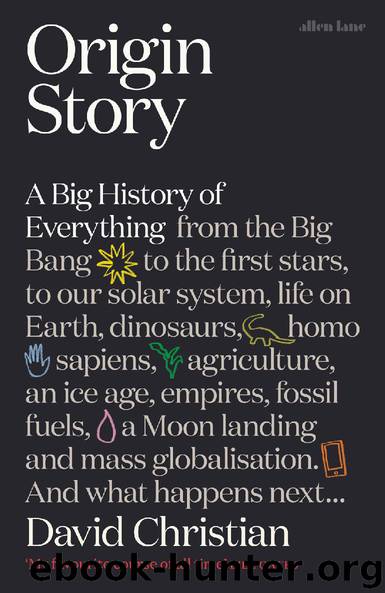Origin Story: A Big History of Everything by David Christian

Author:David Christian [Christian, David]
Language: eng
Format: epub
Tags: Anthropology, Cosmology, History, Natural History, Nature, Physical, Science, Social Science
ISBN: 9780241254691
Google: 7ZRUDwAAQBAJ
Amazon: B07CF85LFX
Publisher: Penguin Books
Published: 2018-05-22T03:00:00+00:00
Chapter 8
Farming: Threshold 7
When Adam delved and Eve span, Who was then the gentleman? From the beginning all men by nature were created alike, and our bondage or servitude came in by the unjust oppression of naughty men. For if God would have had any bondmen from the beginning, he would have appointed who should be bond, and who free.
—JOHN BALL, SERMON PREACHED DURING THE ENGLISH PEASANTS’ REVOLT
Our ancestors lived as foragers for the first two hundred thousand years or more of our history. A constant trickle of innovations ensured that they would forage with increasing efficiency and in an increasing diversity of environments, until, by ten thousand years ago, at the end of the last ice age, humans were living in most parts of the world. In the past ten thousand years, human lifeways were transformed by a cascade of innovations that we describe as farming or agriculture.
Farming was a mega-innovation, a bit like photosynthesis or multicellularity. It set human history off on new and more dynamic pathways by helping our ancestors tap into larger flows of resources and energy that allowed them to do more things and create new forms of wealth. Like a gold rush, the bonanza of energy would generate a frenzy of change. Eventually it would transform the human relationship to the biosphere because, as farming societies grew, they supported much larger populations and evolved many more moving parts than foraging societies. More energy, resources, and people and more links between communities generated positive feedback cycles that accelerated change. For all these reasons, farming counts as our seventh threshold of increasing complexity.
The potential for transformative innovations had existed since collective learning first took off, but now that potential began to be realized as a result of three main Goldilocks conditions: new technologies (and increasing understanding of environments generated through collective learning), increasing population pressure, and the warmer climates of the Holocene epoch.
What Is Agriculture?
As human communities got better at collecting and managing information about their environments, they gathered and hunted with increasing understanding and skill, and their impacts on surrounding plants, animals, and landscapes grew. Fire-stick farming, for example, transformed vast areas, as it increased the production of plants and animals that were useful for humans. When Captain Cook and his crew sailed north along the east coast of Australia in 1770, they did not see wilderness. They saw distant spirals of smoke as Australians fired the land, and they saw landscapes as altered by human activity as the country gardens of their English homeland. Australia’s megafauna were long gone. The fire-loving eucalyptus that now dominated so many Australian landscapes were there because of thousands of years of fire-stick farming.
Farmers, like foragers, used information accumulated over thousands of years. But they used it in new ways that would take human manipulation of the environment to an entirely new level.
The basic principle of farming is simplicity itself. Farmers use their environmental knowledge to increase the production of those plants and animals they find most useful and to reduce the production of those they can’t use.
Download
This site does not store any files on its server. We only index and link to content provided by other sites. Please contact the content providers to delete copyright contents if any and email us, we'll remove relevant links or contents immediately.
The Lonely City by Olivia Laing(4190)
Animal Frequency by Melissa Alvarez(3822)
All Creatures Great and Small by James Herriot(3602)
Walking by Henry David Thoreau(3301)
Exit West by Mohsin Hamid(3279)
Origin Story: A Big History of Everything by David Christian(3202)
COSMOS by Carl Sagan(3009)
How to Read Water: Clues and Patterns from Puddles to the Sea (Natural Navigation) by Tristan Gooley(2943)
Hedgerow by John Wright(2832)
The Inner Life of Animals by Peter Wohlleben(2819)
Origin Story by David Christian(2747)
How to Read Nature by Tristan Gooley(2737)
Project Animal Farm: An Accidental Journey into the Secret World of Farming and the Truth About Our Food by Sonia Faruqi(2726)
How to Do Nothing by Jenny Odell(2711)
Water by Ian Miller(2655)
A Forest Journey by John Perlin(2643)
The Plant Messiah by Carlos Magdalena(2505)
A Wilder Time by William E. Glassley(2413)
Forests: A Very Short Introduction by Jaboury Ghazoul(2397)
